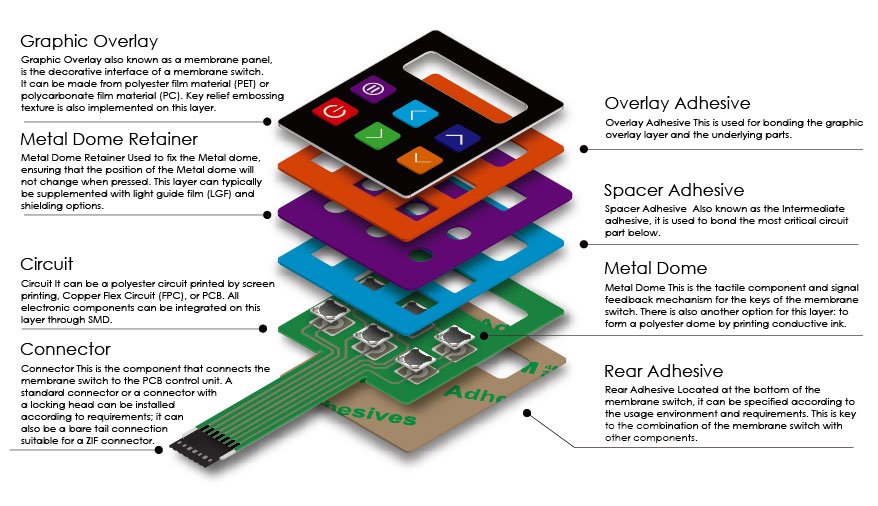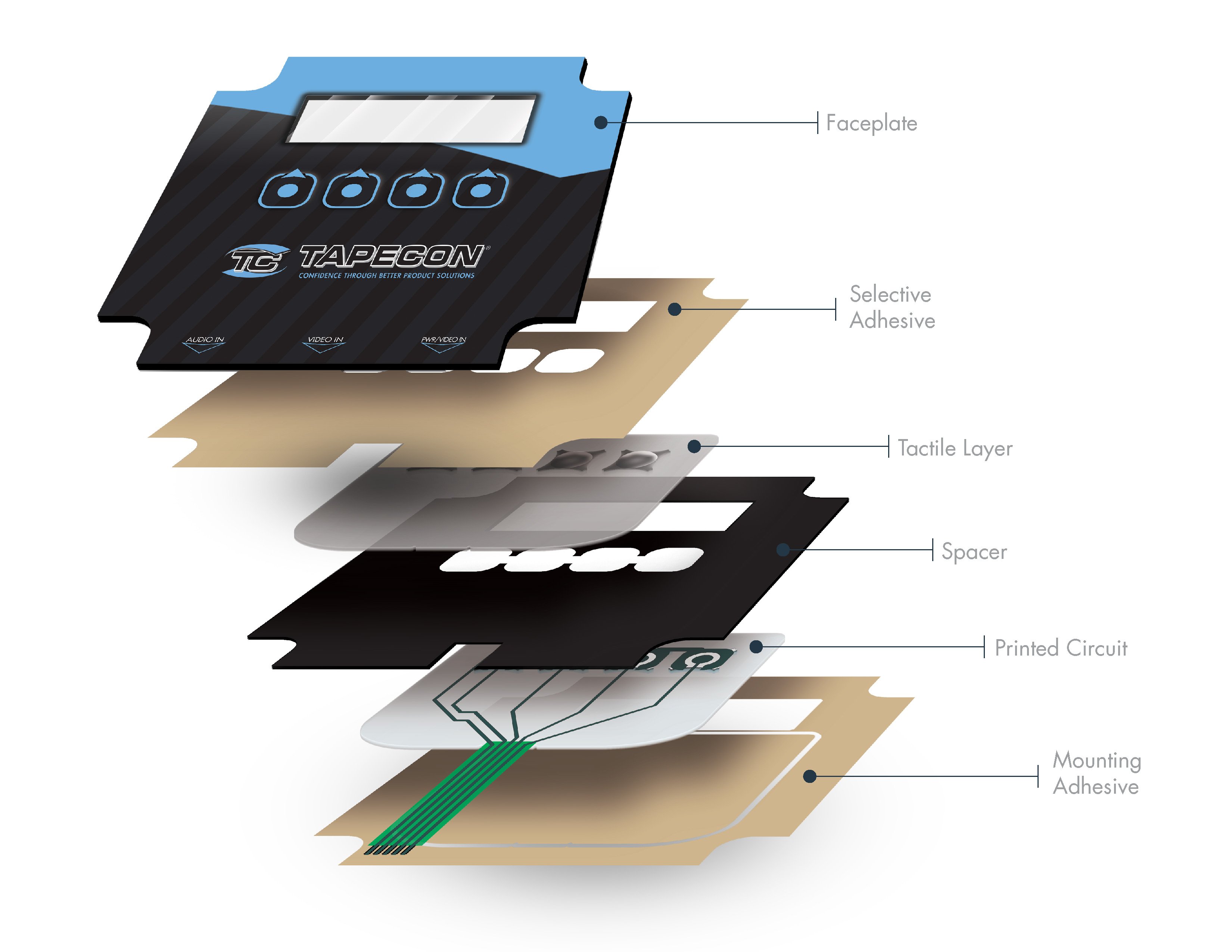Membrane switch durability: Why it matters under tough conditions
Wiki Article
The Production Refine Behind Membrane Switch: What You Need to Know
The manufacturing procedure behind membrane layer switches over combines mindful style, material option, and high quality control. It begins with understanding the details of membrane button layout and progresses through different stages, consisting of material choices and printing strategies. Each phase plays an important role in ensuring capability and toughness. Nonetheless, the complexities of layer construction and the extensive screening standards may disclose insights that are not promptly apparent. What lies beyond these foundational elements?Recognizing Membrane Change Layout
Membrane buttons may appear straightforward at very first glimpse, their design entails elaborate factors to consider that ensure performance and toughness. The layout process begins with an extensive understanding of user demands, consisting of the interface's designated application and environmental elements. Ergonomics is a key element, as the layout should assist in simplicity of usage while ensuring that responsive responses meets user expectations.Moreover, the layering of parts, such as graphic overlays, sticky layers, and conductive traces, must be precisely crafted. membrane switch. This split configuration not just influences the switch's responsiveness however additionally affects its longevity. Interest is provided to the sealing methods utilized to shield against wetness and dirt, which might endanger efficiency. Furthermore, layout considerations expand to visual appeals, where color design and visual quality improve individual experience. Eventually, the layout of membrane switches equilibriums functionality, individual experience, and resilience, guaranteeing that they fulfill the needs of numerous applications properlyMaterials Used in Membrane Layer Switch Over Production
When selecting products for membrane layer switch manufacturing, it is vital to consider both performance and toughness. The main products consist of polyester and polycarbonate films, which give adaptability and stamina. These movies are typically covered with adhesive to ensure correct bonding to substratums. Conductive inks, typically composed of silver or carbon, are critical for developing electric links within the button, allowing for trustworthy operation.Additionally, a safety layer, such as a tough coat, is frequently used to improve scratch resistance and durability. The choice of backing product, such as acrylic or foam, can significantly affect the switch's tactile feel and overall user experience. Various environmental variables, including temperature level and moisture, need to assist material selection to ensure peak efficiency in specific applications. Inevitably, the ideal combination of materials adds to the membrane button's performance and life-span, making educated options essential for producers.The Printing Refine: Creating Video and Text
The printing procedure in membrane layer button manufacturing plays a considerable role in generating top quality graphics and text. Various visuals style methods are used to assure aesthetic allure and performance, while careful ink selection approaches are necessary for resilience and efficiency. Recognizing these components is fundamental for attaining ideal results in membrane button layout.Graphic Layout Techniques
Graphic layout strategies play a crucial duty in the printing procedure of membrane switches, as they specify just how graphics and message will eventually appear on the final product. Effective visuals layout involves the calculated use of formats, typefaces, and shades to boost readability and aesthetic charm. Designers often make use of vector graphics for scalability, making certain that images continue to be sharp at numerous sizes. In addition, focus to contrast and placement is vital, as it influences user interaction and visual quality. The consolidation of branding components, such as logo designs, should be handled with like keep brand name honesty. Generally, thoughtful graphic design strategies add substantially to the functionality and appearance of membrane layer switches, impacting user experience and product efficiency.Ink Selection Techniques
Selecting the ideal ink is essential for attaining the wanted aesthetic top quality and sturdiness in membrane layer switch production. Numerous ink kinds are utilized, consisting of solvent-based, water-based, and UV-curable inks. Each type offers unique qualities, such as adaptability, resistance, and adhesion to environmental factors. Solvent-based inks are usually preferred for their toughness and vibrant colors, while water-based inks are more ecologically friendly however might have limitations in bond. UV-curable inks offer fast treating and durable performance. Additionally, shade matching methods assure that the picked inks straighten with style specs. Inevitably, the choice of ink should think about aspects such as application technique, substratum compatibility, and end-use needs to achieve remarkable lead to membrane layer button graphics and message.Layer Construction and Setting Up

Material Choice Process
A careful choice of products is important in the production procedure of membrane layer switches, as it straight affects functionality and longevity. The primary products utilized include polyester, polycarbonate, and various conductive inks. Polyester is typically favored for its outstanding resistance to chemicals and abrasion, making it appropriate for harsh settings. Polycarbonate, on the other hand, supplies premium quality and effect resistance, which is beneficial for applications needing exposure and toughness. Conductive inks, commonly composed of silver or carbon, are important for developing reputable electrical pathways. Additionally, the option of sticky materials affects the overall integrity of the switch - membrane switch. Examining elements such as environmental exposure, responsive responses, and visual requirements guides suppliers in picking the best materials for their particular applicationsLayer Bond Techniques
Sticking layers in membrane switch construction is a vital process that ensures capability and long life. Numerous attachment techniques are used to protect excellent bonding in between layers, which typically include making use of adhesives, warm, and stress. Pressure-sensitive adhesives (PSAs) are typically made use of for their simplicity of application and instant bonding capabilities. Furthermore, thermal bonding methods can be used, where heat is made use of to trigger sticky residential or commercial properties, safeguarding a solid bond. The selection of attachment method mainly depends on the products included and the certain application needs of the membrane layer button. Proper alignment and consistent application of adhesives are vital to avoid issues, protecting the switch runs successfully throughout its designated lifespan.Quality Assurance Procedures
Ensuring top quality control throughout the layer building and assembly of membrane layer buttons is vital for preserving performance and reliability. This procedure generally includes several important steps, consisting of complete examinations at each phase of manufacturing. Producers utilize sophisticated testing techniques, such as peel examinations and bond evaluations, to verify the honesty of layer bonds. Additionally, visual examinations are performed to determine any type of issues in printing or product incongruities. Environmental conditions, such as temperature and humidity, are meticulously kept track of to guarantee optimal curing and attachment. Moreover, routine calibration of devices helps preserve accurate production criteria. By executing these quality assurance measures, suppliers can substantially reduce the risk of product failure, ensuring that the last membrane layer changes fulfill the required specifications and client assumptions.Testing and High Quality Control Steps

Advancements in Membrane Layer Switch Technology
As developments in innovation continue to evolve, membrane buttons are taking advantage of cutting-edge advancements that boost their performance and individual experience. One notable advancement is the combination of capacitive touch modern technology, address which enables for even more intuitive and receptive interface. This change not just boosts aesthetic appeals yet additionally decreases mechanical damage, expanding the life expectancy of the switches.Additionally, improvements in visuals overlay products have resulted in improved look at this web-site durability and resistance to environmental aspects such as moisture and UV light. These materials now offer improved quality and brightness, further elevating the visual appeal.Furthermore, the consolidation of smart innovation is changing membrane switches over into interactive control panels, enabling connectivity with IoT gadgets. This connectivity promotes a smooth user experience, leading the means for applications in different sectors, from medical care to consumer electronic devices. Jointly, these innovations position membrane switches over as important elements in modern device design.Frequently Asked Questions
How much time Does the Membrane Layer Switch Manufacturing Process Take?
The period of the membrane switch production procedure can differ considerably. Variables such as intricacy, materials made use of, and manufacturing volume impact timelines, with regular manufacturing ranging from a couple of days to a number of weeks for conclusion.What Are the Usual Applications for Membrane Buttons?
Membrane layer buttons are generally utilized in different industries, including automobile controls, family home appliances, medical tools, and consumer electronic devices (membrane switch). Their adaptability and sturdiness make them ideal for applications requiring user-friendly interfaces and trusted performance in varied atmospheresCan Membrane Layer Switches Over Be Personalized for Details Demands?

What Is the Life expectancy of a Regular Membrane Layer Change?
The life expectancy of a typical membrane switch differs, yet typically, it ranges from 1 to 5 million cycles. Factors such as usage, atmosphere, and material top quality substantially influence toughness and total performance gradually.

Are Membrane Layer Changes Eco-friendly?
The environmental friendliness of membrane switches over varies. Some materials used might not be recyclable, while others can be environmentally friendly. The total effect depends on producing materials and techniques, requiring careful consideration during choice and disposal. The production process behind membrane layer changes combines mindful design, material selection, and high quality control. It starts with understanding the details of membrane layer switch design and advances with numerous phases, consisting of product choices and printing techniques. When selecting products for membrane layer switch manufacturing, it is important to contemplate both efficiency and sturdiness. A mindful selection of products is vital in the manufacturing process of membrane layer buttons, as it straight influences functionality and longevity. The option of adhesion technique largely depends on the materials entailed and the particular application needs of the membrane switch.Report this wiki page